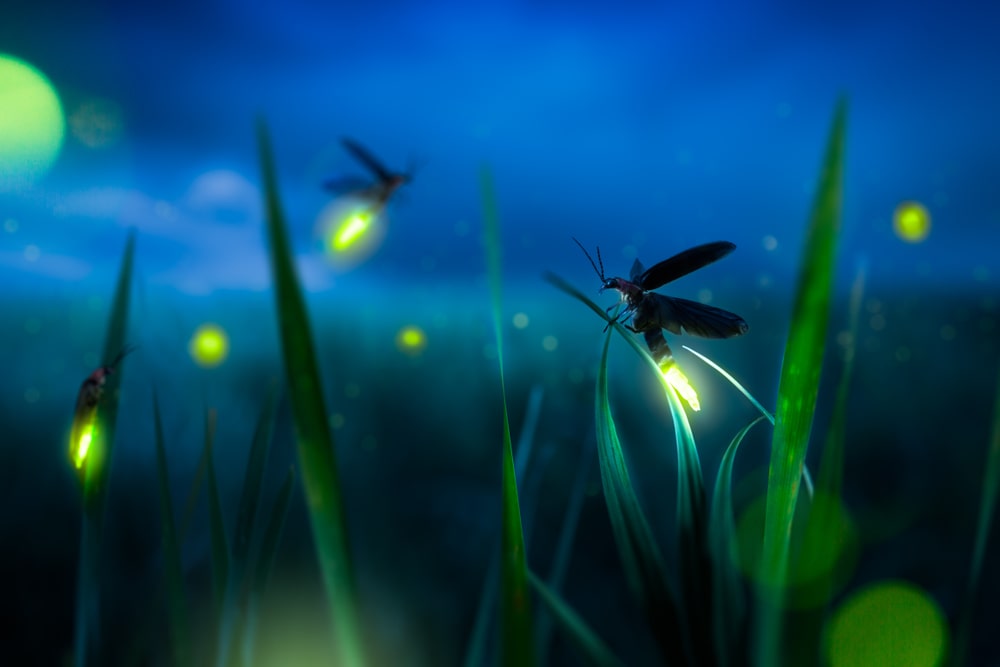One of the things I enjoy most in my wildlife-friendly yard is watching the fireflies. What kid hasn’t run around their back yard at dusk chasing fireflies?
When I was a kid, I remember summer evenings at my grandparents’ house. My grandparents, my parents, sometimes my favorite aunt and uncle, all sat on the front porch drinking iced tea. My sister, brother, two cousins, and I ran around the huge front yard catching fireflies and holding them in our hands. Years later, those memories are still so vivid.
What Are Fireflies, Really?
Fireflies are not flies at all but beetles, belonging to a family called Lampyridae. There are several species of fireflies native to Virginia. Most belong to either the genus Photinus or Photuris.
Fireflies like grassy or wooded areas near water sources. They also like warm humid weather—welcome to Virginia in the summer!
How Fireflies Produce Light
Fireflies produce light with cells called photocytes that contain a chemical called luciferin. An enzyme, called luciferase, interacts with luciferin to make light. The light produced by a firefly is cold—generating no heat. Nearly 100% of the energy used is given off as light. In contrast, the energy used by a regular incandescent light bulb gives off 10% light and 90% heat.
Fireflies Are Good for Your Garden
Fireflies spend most of their lives as larvae—glow worms. The larvae are predators and feed on slugs, snails, and other insect larvae. The females lay eggs soon after mating and the larvae hatch shortly thereafter and feed all summer. They hibernate over winter, feed again in the spring, then pupate for a short two-week period before hatching in early summer.
It’s usually the males we see lighting up our yards on a summer night, signaling for a mate. Each species has its own particular signal pattern. The females tend to wait in trees or shrubs and when she sees a prospective mate, she signals back.
Some females of the genus Photuris, however, use signaling for a more sinister purpose. She’ll mimic the flashing pattern of females of a different species and when the male approaches expecting to find a mate, he becomes lunch instead. Most fireflies aren’t cannibals however, they eat pollen and nectar.
The Very, Very Big Firefly Show
There are two spots in the United States: Congaree National Park in South Carolina and the Great Smoky Mountains near Elkmont, Tennessee where fireflies, sometime in early June, will inexplicably begin to synchronize their blinking. Scientists are not sure why. But that must be pretty incredible to see.
In the United States, one of the most famous sightings of fireflies blinking in unison occurs annually near Elkmont, Tennessee in the Great Smoky Mountains during the first weeks of June. Congaree National Park in South Carolina is another host to this phenomenon.
Experts Are Concerned
Some experts are concerned that firefly populations are dwindling. So much of their native environment has been destroyed. So many ponds have been filled in to turn into housing developments. Scientists have also found that fireflies are sensitive to the same chemical pesticides that are killing our bees—neonicotinoids. And excessive nighttime lighting—street lights, porch lights, even car headlights may interfere with their mating cycles.
How to Encourage Fireflies to Visit Your Yard
To encourage fireflies in your yard, we recommend:
- Mowing your grass a little higher—fireflies hide here during the day.
- Planting a variety of flowers and trying to leave night lights off.
- Considering installing a water feature of some sort—a fountain, a pond, even a birdbath.
Our Garden Experts Are Here for You!
For more suggestions about making your yard environmentally friendly, stop by the Greenhouse and talk with one of our garden experts. We all love gardening and we love sharing tips that will make your garden a special place.

